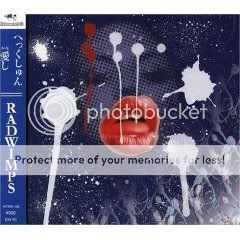| Radwimps 3: Mujintō ni Motte Ikiwasureta Ichimai | ||||
|---|---|---|---|---|
| Studio album by | ||||
| Released | February 15, 2006 | |||
| Recorded | 2005–2006 | |||
| Genre | ||||
| Length | 49:56 | |||
| Language | Japanese, English | |||
| Label | Toshiba EMI | |||
| Producer | Junji Zenki (executive producer) Ryō Takagi | |||
| Radwimps chronology | ||||
| ||||
| Singles from Radwimps 3 | ||||
| ||||
- [flac] radwimps radwimps.rar [flac] radwimps radwimps2 ~発展途上~.rar [flac] radwimps radwimps3 ~無人島に持っていき忘れた一枚~.rar [flac] radwimps radwimps4 ~おかずのごはん~.rar [flac] radwimps 絶体絶命.rar [2009.03.11] RADWIMPS - アルトコロニーの定理.rar.
- [Album] RADWIMPS – RADWIMPS no Hajimari Hajimari no Matome [FLAC + MP3] Posted by jpmedia on Leave a comment (0) Go to comments RADWIMPS – RADWIMPSのはじまりはじまりのまとめ.

Radwimps 3: Mujintō ni Motte Ikiwasureta Ichimai (無人島に持っていき忘れた一枚, 'The CD I Forgot To Take To The Deserted Island'), stylised as RADWIMPS 3 ~Mujintō ni Motte Ikiwasureta Ichimai~, is Japaneserock band Radwimps' third album, and debut major label album under Toshiba EMI, released on February 15, 2006.[1]
Please don't hesitate to email us if you have any questions, suggestions or issues. We also welcome feedback on how we can improve our services.
The album was an extremely long seller. It sold 13,800 copies in its first week and spent a single week in the top 40,[2] however has spent 161 weeks charting in the top 300 since its release,[3] and has been certified a platinum selling album by the RIAJ.[4]
- 5Chart rankings
Background and development[edit]
Radwimps 3 was recorded in three different recording sessions, with the first in Summer 2005. The band continued to record until September 2005, as the members still had high school to attend in October.[5] Vocalist Yojiro Noda felt the separated recording sessions made the process much more fresh, and that he could put power into every song they recorded.[5] This technique was different to what the band did for their first two albums, which were collections of recordings accumulated until the band had enough material for an album.[5] Bassist Yusuke Takeda noted how their previous technique made album producing feel like work, and that it made the process dull.[5]Radwimps 3 was finished being recorded in December 2005.[6] Another new aspect in recording the band tried with Radwimps 3 was for all members to record simultaneously, as opposed to having each instrument recorded separately. The members believed such a technique helped the members understand the 'feeling' of the band.[5]
Noda felt like the most important aspect of the album was lyrics.[7]
The band's debut major label single, 'Nijūgoko-me no Senshokutai,' was an attempt by Noda to 'express the world of music,' and found it hard to fill the song with rhythm or space.[8] The album-preceding single, 'EDP (Tonde Hi ni Iru Natsu no Kimi),' was created with the concept of the band making an incomprehensible song.[8] The acronym EDP has no particular meaning.[9]
Of the songs on the album, six are sung completely in Japanese, two primarily in Japanese with English phrases, and four primarily in English with Japanese phrases.
Promotion and release[edit]
The first single from the album was 'Hexun' in May 2005, released while the band was still independent. The band made their major debut in November 2005 with the single 'Nijūgoko-me no Senshokutai,' followed by 'EDP (Tonde Hi ni Iru Natsu no Kimi)' in January 2006, a month before the album's release.
After the album's release, the song 'Otogi' received a music video, directed by Daisuke Shimada.[10]
Commercial reception[edit]
The album debuted at number 13 on Oricon's albums chart, falling out of the top 30 by the next week.[2][11] However, the album consistently charted in the top 300 album chart for every week for the rest of 2006, until the end of September 2008.[2] The album began regularly appearing on the album's chart again in January 2009, until the end of June 2009, after which it has sporadically recharted. In total, the album has spent 161 weeks on the top 300 albums chart as of March 2011.[2] While the first weeks sales of the album only totalled 14,000, the current total has reached 189,000 copies.[2] Furthermore, the album has been certified as a platinum album, having more than 250,000 copies shipped to stores across Japan.[4]
The song 'Saidai Kōyakusū' received a gold digital certification in March 2009, for the song being downloaded to cellphones more than 100,000 times since its release in February 2006.[12]
Track listing[edit]

All tracks written by Yojiro Noda.
| No. | Title | Length |
|---|---|---|
| 1. | '4645' (Yoroshiko, 'Best Regards') | 2:42 |
| 2. | 'September-san' (セプテンバーさんSeputenbā-san, 'Mr. September') | 5:07 |
| 3. | 'EDP (Tonde Hi ni Iru Natsu no Kimi)' (イーディーピー~飛んで火にいる夏の君~Ī Dī Pī, 'Summer You in the Dancing Fire') | 2:58 |
| 4. | 'Tojita Hikari' (閉じた光 'Switched-off Light') | 4:28 |
| 5. | 'Nijūgoko-me no Senshokutai' (25コ目の染色体 'The 25th Chromosome') | 5:16 |
| 6. | 'Yayu' (揶揄 'Banter') | 3:36 |
| 7. | 'Hotaru' (螢 'Firefly') | 4:18 |
| 8. | 'Otogi' (おとぎ 'Fairy Tale') | 3:28 |
| 9. | 'Saidai Kōyakusū' (最大公約数 'The Greatest Common Denominator') | 4:34 |
| 10. | 'Hexun' (へっくしゅんHekkushun) | 3:34 |
| 11. | 'Tremolo' (トレモロToremoro) | 3:20 |
| 12. | 'Saigo no Uta' (最後の歌 'The Last Song') | 6:26 |
| Total length: | 49:56 | |
Chart rankings[edit]
Radwimps debut major label single, the mid-tempo 'Nijūgoko-me no Senshokutai.' Upbeat pop-punk song 'EDP (Tonde Hi ni Iru Natsu no Kimi)' was released as the album's preceding single. | |
| Problems playing these files? See media help. | |
| Chart | Peak position |
|---|---|
| Oricon daily albums[13] | 9 |
| Oricon weekly albums[11] | 13 |
Sales and certifications[edit]
| Chart | Amount |
|---|---|
| Oricon physical sales[2] | 189,000 |
| RIAJ physical shipping certification[4] | Platinum (250,000+) |
Release history[edit]
| Region | Date | Format | Distributing Label |
|---|---|---|---|
| Japan | February 15, 2006[1] | CD, digital download | Toshiba EMI |
| March 4, 2006[14] | Rental CD | ||
| South Korea | February 15, 2006[15] | Digital download | Warner Music Korea |
References[edit]
Radwimps Radwimps 3 Rares
- ^ ab'[CD] RADWIMPS 3 ~無人島に持っていき忘れた一枚~ / RADWIMPS'. Neowing (in Japanese). Retrieved April 11, 2011.
- ^ abcdef'オリコンランキング情報サービス「you大樹」' [Oricon Ranking Information Service 'You Big Tree']. Oricon. Retrieved April 11, 2011. (subscription only)
- ^RADWIMPS 3~無人島に持っていき忘れた一枚~/RADWIMPS. Oricon (in Japanese). Retrieved April 11, 2011.
- ^ abcゴールド等認定作品一覧 2010年05月 [Works Receiving Certifications List (Gold, etc) (May 2010)]. RIAJ (in Japanese). June 10, 2010. Retrieved January 19, 2011.
- ^ abcde'メジャー・デビュー後、2枚のシングルを経て、ついに2/15にフル・アルバムをリリースした4ピース・バンドRADWIMPSを直撃!' [Direct hit by Radwimps, a four piece band who, after a major debut and two singles, have finally released a full album on February 15!]. Vibe-Net (in Japanese). February 28, 2006. Retrieved February 9, 2011.
- ^'Interview with Radwimps'. Excite Japan Co., Ltd (in Japanese). 2006. Retrieved February 10, 2011.
- ^'Deep Dive - Radwimps'. Amazon (in Japanese). 2006. Retrieved February 9, 2011.
- ^ ab'Special Interview Radwimps'. Oricon (in Japanese). January 18, 2006. Retrieved February 9, 2011.
- ^'RADWIMPS 特集' [Radwimps Feature]. Neowing (in Japanese). 2006. Retrieved February 9, 2011.
- ^'アーティスト名 RADWIMPS 楽曲名 おとぎ' [Artist Name: Radwimps. Song Name: 'Otogi']. Space Shower (in Japanese). Retrieved February 6, 2011.
- ^ abOricon. 'RRADWIMPS 3~無人島に持っていき忘れた一枚~ - RADWIMPS' (in Japanese). Retrieved April 10, 2011.
- ^レコード協会調べ 3月度有料音楽配信認定 <略称:3月度認定>. RIAJ (in Japanese). April 20, 2009. Retrieved January 21, 2011.
- ^'シングル デイリーランキング-ORICON STYLE ランキング' [Single Daily Ranking - Oricon Style Ranking]. Oricon. February 15, 2006. Archived from the original on February 15, 2006. Retrieved May 9, 2011.
- ^'RADWIMPS 3~無人島に持っていき忘れた1枚~/RADWIMPS'. Tsutaya. 2006. Retrieved April 11, 2011.
- ^'Radwimps 3 ~無人島に持っていき忘れた一枚~' (in Korean). Bugs!. Retrieved March 29, 2013.
Retrieved from 'https://en.wikipedia.org/w/index.php?title=Radwimps_3:_Mujintō_ni_Motte_Ikiwasureta_Ichimai&oldid=866678668'